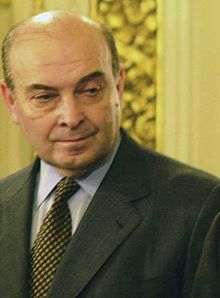Domingo Cavallo
| Domingo Cavallo | |
|---|---|
 |
|
| Minister of Economy of Argentina | |
|
In office 20 March 2001 – 20 December 2001 |
|
| President | Fernando de la Rúa |
| Preceded by | Ricardo López Murphy |
| Succeeded by | Jorge Capitanich |
|
In office 1 February 1991 – 6 August 1996 |
|
| President | Carlos Menem |
| Preceded by | Antonio Erman González |
| Succeeded by | Roque Fernández |
| Minister of Foreign Affairs | |
|
In office 8 July 1989 – 31 January 1991 |
|
| President | Carlos Menem |
| Preceded by | Susana Ruiz Cerruti |
| Succeeded by | Guido di Tella |
| President of the Central Bank of Argentina | |
|
In office 2 July 1982 – 26 August 1982 |
|
| President | Reynaldo Bignone |
| Preceded by | Egidio Iannella |
| Succeeded by | Julio González del Solar |
| Personal details | |
| Born |
July 21, 1946 San Francisco, Córdoba |
| Nationality | Argentine |
| Political party |
Justicialist Party (2012–present) |
| Other political affiliations |
Independent (1982–1996) Action for the Republic (1996–2012) |
| Spouse(s) | Sonia Abrazián |
| Alma mater |
National University of Córdoba (1968) Harvard University (1977) |
Domingo Felipe "Mingo" Cavallo (born July 21, 1946) is an Argentine economist and politician. He has a track record of public service and is known for implementing the Convertibilidad plan, which fixed the dollar-peso exchange rate at 1:1 between 1991 and 2001. This brought the Argentine inflation rate down from over 1,300% in 1990 to less than 20% in 1992 and nearly to zero during the rest of the 1990s. Guided by his politics, Argentina entered into one of the most difficult crisis in its history. He is also well known for implementing the corralito, which restrained Argentine citizens from withdrawing money from their bank accounts. This was followed by the December 2001 riots and the fall of President Fernando de la Rúa. In 2015, he was sentenced for embezzlement, following an appeal. A definitive sentence still awaits.
Cavallo was born in San Francisco, Córdoba Province to Florencia and Felipe Cavallo, Italian Argentine immigrants from the Piedmont Region. He graduated with honors in Accounting (1967) and Economics (1968) at the National University of Córdoba, where he earned his Doctorate in Economics in 1970. He married the former Sonia Abrazián in 1968, and had three children. He would later enroll at Harvard University, where he earned a second doctorate in Economics in 1977.
His involvement in politics began when he was elected as a student representative to the highest government body of the Economics School (1965–1966). He acted as undersecretary of Development of the provincial government (1969–1970), director (1971–1972) and vice president of the Board (1972–1973) of the provincial Bank and undersecretary of Interior of the national government.
...
Wikipedia
